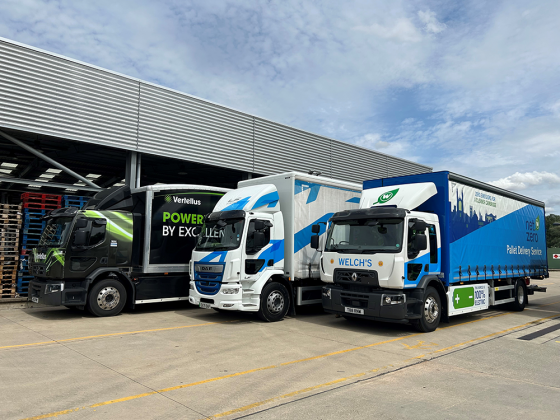Make room for the platoon
Self-driving truck platoons hold great potential to make British road transport safer, cleaner and more efficient in the future. Trials have already been staged in Europe, and environmental benefits are just one of the positive outcomes of the system.
 Platoons of self-driving vehicles on European roads were once thought of as something of the future, a concept or idea with little substance. However the futuristic mode of transportation surprised many people this month as platoons arrived on continental roads as a result of a challenge thrown down by the Dutch government.
Platoons of self-driving vehicles on European roads were once thought of as something of the future, a concept or idea with little substance. However the futuristic mode of transportation surprised many people this month as platoons arrived on continental roads as a result of a challenge thrown down by the Dutch government.
Platooning, involving a group of centrally controlled automated or semi-automated trucks, uses computer communication technology to electronically couple vehicles to drive in a close formation. Platooning is beneficial in many ways: allowing for shorter gaps between trucks on the road, thus freeing up road space for other vehicles; using autonomous technology for an instant reaction to changes in speed by the vehicle in front; and most importantly allowing trucks to use up to 10 per cent less fuel by taking advantage of the slipstream created by the most advanced truck.
Truck platooning is part of the global commercial vehicle industry’s integrated approach to further reducing CO2 emissions, looking at all of the elements that affect emissions during the use of a truck. Besides the vehicle itself, trailer design, alternative fuels, logistics, infrastructure and ITS technology (such as platooning) all play a decisive role in bringing down CO2 emissions.
The Truck Platooning Challenge
The Truck Platooning Challenge was conceived in 2015 and was organised by Rijkswaterstaat, a body responsible for the design, construction, management and maintenance of roads and waterways in the Netherlands, and required coordinated cross-border planning, with different countries currently having different rules for platooning. Six truck manufacturers – DAF Trucks, Daimler, Iveco, MAN, Scania and Volvo Group – were invited to send self-driving platoons from several European cities to Rotterdam in the Netherlands, using public roads the whole way, for the European Truck Platooning Challenge final.
On 6 April, the six platoons of self-driving trucks converged in Rotterdam, successfully marking the first time that trucks equipped with such technology have travelled across international borders. The platoons involved in the challenge were monitored and filmed from the air from start to finish so as to provide insights into how other traffic responds to them.
Melanie Schultz van Haegen, Dutch infrastructure and environment minister, said: “Truck platooning will ensure cleaner and more efficient transport. Self‑driving vehicles also contribute to road safety because most accidents are caused by human failure.”
This is all positive news for the UK’s commercial vehicle sector. The trials proved that truck operators can use the technology to reduce fuel consumption because of the reduced air resistance caused by streamlining the vehicles in close proximity to one another. So where and when are we likely to see truck platooning on our roads?
The technology exists already, and has been used in many projects, but it is the belief in full adoption that is rendering the project a future idea in Britain, rather than a present plan. The technologies need to be brought together and unified, and that is what Daimler are doing.
Innovative solutions
Sven Ennerst, head of Truck Product Engineering at Daimler, is the pioneer of the Future Truck 2025 Mercedes-Benz. Ennerst has seen projects rolled out in the US state of Nevada in May last year, and more recently in the German state of Baden-Wurttemberg. Arguing that what was used in the successful trials to be ‘available today’, Ennerst claims that the technology is near wider series production.
One of the main obstacles hindering adoption is the question of driver activity – a question posing several issues for fleet managers. Ennerst believes that the question holds more possibility than hindrance – costs will be cut and the driver shortage problem amended.
Ennerst says: “We expect a change in the organisation of the freight forwarding industry. The driver will take over many of the traffic planner’s functions. He will become more of a transport manager than a driver, from our point of view.”
Room for a UK platoon?
In the UK, a project led by Tructyre Fleet Management in Hampshire is among the eight recently to have been awarded government funding totalling £20 million to research and develop autonomous vehicles. The ‘Pathway to Autonomous Commercial Vehicles’ project, which will develop an innovative solution to monitor key information from the vehicle and predict safety risks based on analytics, also involves the University of Portsmouth, Satellite Applications Catapult and RL Automotive.
The project’s aim is said to be development of ‘an innovative solution to monitor key information from the vehicle and predict safety risks based on analytics’. A tyre pressure monitoring system (TPMS) is at the heart of the research.
Total project put at £1.2 million, with £900,000 coming from the Department for Business, Innovation & Skills (BIS).
This article was created with the help of Transport News Brief from the Society of Manufacturers and Traders (SMMT)






